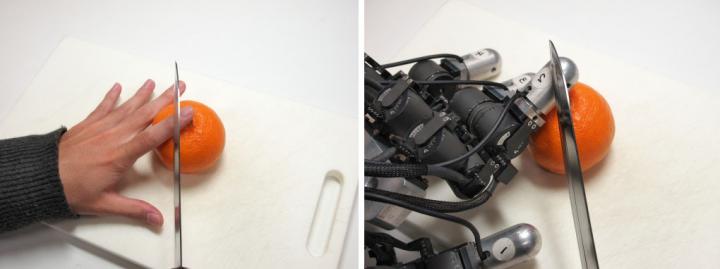Can humans empathize with robots? The knife test.
November 16, 2015

Examples of pictures of humans and robots in pain or perceived pain (credit: Toyohashi University of Technology)
Researchers at Toyohashi University of Technology and Kyoto University have found the first neurophysiological evidence of humans’ ability to empathize with robots in perceived pain — at least when it comes to losing a finger.
They monitored event-related electroencephalography (EEG) signals from 15 healthy adults who were observing pictures of either a human or robotic hand in painful or non-painful situations, such as a finger being cut by a knife.
They found that brain potentials related to humanoid robots in (perceived) pain were similar to those for humans in pain, but with one exception: The ascending phase of the P3 wave (350-500 ms after the stimulus presentation) did not show an effect for a robot in perceived pain, compared to a human. The researchers suggest that could be explained by the perceived unnaturalness of robot hands being cut by knives.
However, the researchers agree the experiment was not conclusive. What about a robot with a human size-hand with thinner fingers? Or more natural-looking features (no wires or metal)? Or no actual fingers? Or an unfriendly robot?
Abstract of Measuring empathy for human and robot hand pain using electroencephalography
This study provides the first physiological evidence of humans’ ability to empathize with robot pain and highlights the difference in empathy for humans and robots. We performed electroencephalography in 15 healthy adults who observed either human- or robot-hand pictures in painful or non-painful situations such as a finger cut by a knife. We found that the descending phase of the P3 component was larger for the painful stimuli than the non-painful stimuli, regardless of whether the hand belonged to a human or robot. In contrast, the ascending phase of the P3 component at the frontal-central electrodes was increased by painful human stimuli but not painful robot stimuli, though the interaction of ANOVA was not significant, but marginal. These results suggest that we empathize with humanoid robots in late top-down processing similarly to human others. However, the beginning of the top-down process of empathy is weaker for robots than for humans.